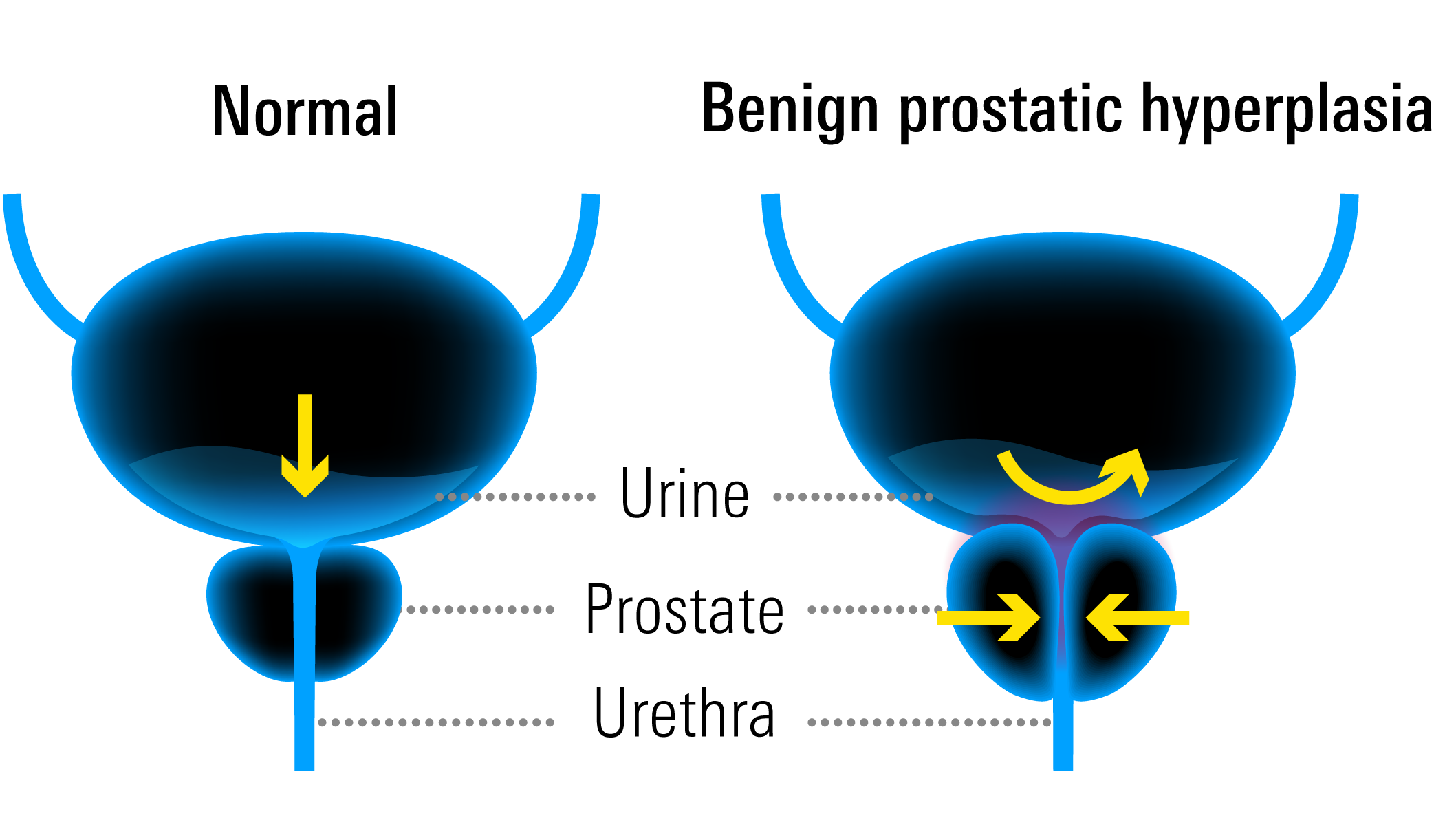What is Benign Prostatic Hyperplasia?
Benign prostatic hyperplasia, often referred to as BPH, is the enlargement of the prostate that is usually benign (non-cancerous) and is common in men as they age. When your prostate becomes enlarged, it usually interferes with one’s ability to urinate due to the fact that the prostate completely surrounds your urethra—the tube that carries urine from your bladder to outside of your body.

Symptoms
The severity of symptoms varies and usually has nothing to do with how enlarged the prostate is. Some common symptoms include:
- Frequent and urgent need to urinate
- Increased frequency of urination at night
- Difficulty starting urination
- Weak urine stream or a stream that starts and stops
- Dribbling at the end of urination
- Inability to completely empty bladder
Less common signs and symptoms include:
- Urinary tract infection
- Inability to urinate
- Blood in the urine
Diagnosis

A physician can perform a series of different tests to determine if your prostate is enlarged and if that is what is causing your symptoms. These include:
- Rectal exam: The physician inserts a finger into the rectum to check for prostate enlargement.
- Urine test: Analysis of a urine sample can help the physician rule out other causes of your symptoms such as urinary tract infection.
- Blood test: This is usually done to check the function of your kidneys. Malfunctioning kidneys can cause urinary issues as well.
- Prostate-specific antigen (PSA) blood test: PSA is a substance that is produced by your prostate, if these levels are increased, this can indicate an enlarged prostate. Elevated PSA levels can also indicate an infection, surgery or prostate cancer so these results usually need to be used in conjunction with other tests to confirm an enlarged prostate.
- Postvoid residual volume test: This is done to measure your ability to empty your bladder completely. Usually, after urinating, a catheter is inserted into your bladder to measure how much residual urine is left in your bladder.
- 24-hour voiding diary: This is a record of the frequency and amount that you urinate throughout a 24-hour period. That can be useful to determine if you urinate more frequently at night time.
Treatment
There is a wide variety of treatments available for prostate enlargement. These include medications, minimally invasive therapies, and in some cases, surgery. The best treatment plan depends on many factors including the size of your prostate, your age, overall health and the amount of discomfort you are experiencing. Talking with your healthcare provider is important to determine which option is the best course of treatment for your situation.
Medications

Treatment with medications is the most common way to treat the mild to moderate symptoms of prostate enlargement. These options include:
- Alpha blockers: These relax the muscles in the bladder neck and the muscle fibers in the prostate, making urination easier. Alpha blockers include doxazosine (Cardura) and tamsulosin (Flomax) which usually work quickly for men with relatively small prostates.
- 5-alpha reductase inhibitors: These medications shrink your prostate by preventing hormonal changes that cause prostate growth. These include finasteride (Propecia) and dutasteride (Avodart).
- Tadalafil (Cialis): This is a common medication used to treat erectile dysfunction. The 5 mg dose of tadalafil has been shown to help treat the symptoms of an enlarged prostate. Please note that if you are taking tadalafil, it should not be taken in combination with alpha blockers.
Minimally invasive or surgical therapy

These procedures are usually recommended for those with moderate to severe symptoms who had little to no success being treated with medications. You may also be recommended one of these procedures if you have a urinary tract obstruction, bladder stones, blood in the urine or kidney problems. There are many different options for this type of treatment, a few are mentioned below:
- Transurethral resection of the prostate (TURP): A lighted scope is inserted into the urethra, and the surgeon removes all of the prostate except the outer portion. This generally relieves symptoms quickly and most men have a stronger urine flow after the procedure.
- Transurethral incision of the prostate (TUIP): A lighted scope is inserted into the urethra, and the surgeon makes 1-2 small cuts in the prostate gland which will allow urine to pass through the urethra more readily.
- Laser therapy: A high-energy laser is used to destroy or remove overgrown prostate tissue. This type of therapy generally relieves symptoms very quickly and has a lower risk of side effects than non-laser surgeries.
- Prostatectomy: This is usually only performed when the prostate is very large, if you have bladder damage or other complicating factors. For this procedure, the surgeon makes an incision into the lower abdomen to reach the prostate and remove tissue.
Conclusion
If you are having any type of urinary problem, even if you do not find it very bothersome, discuss these issues with your healthcare provider. It is very important to identify or rule out any underlying causes of these symptoms. Untreated urinary problems can lead to an obstruction of the urinary tract.
Have medication questions? Talk with one of our pharmacists and we would be happy to help!